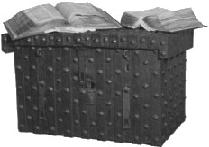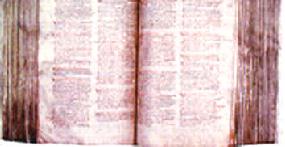|
Bourne in 1086
The great land survey carried out by William I (the Conqueror) in 1086 using details from county surveys compiled during the previous five years is known as the Domesday Book, the name originating from the searches which reminded people of "doomsday" when Christ would call everyone to account. The book, which is written in Latin, comprises two volumes, one covering Essex, Suffolk and Norfolk, and the other the rest of the country with the exception of Durham, Cumberland, Northumberland and Westmorland which were excluded from the survey as being too remote. The aim of the survey was to describe the state of England after the upheavals of the Norman Conquest in 1066 and contain not only detailed information about land holdings, their size, value, ownership and use, but also changes since Edward the Confessor's reign (1042-66). Whether it was designed to meet any immediate need, such as providing a basis for taxation, is unclear. However, by the early 12th century, it was being used as evidence in land and tenure disputes. William ordered the survey of England about twenty years after the Battle of Hastings. The Saxon
Chronicle states that it took place in 1085 while other sources suggest
that it was done in 1086 and the entire documentation took less than a year to
complete. How many ploughs are there in the manor?
Norman officials checked the answers and
the punishments for giving false information were severe. The reeve [a
type of farm manager] from a manor and six peasants were interviewed for
every manor visited. How much it was worth before the invasion
of 1066? Though the survey gives historians a
detailed picture of what life was like in England in 1085-1086, it did
miss out important centres such as Winchester, then a major English city,
and London. In all, 13,418 places were visited and the final record was
produced in Winchester by a monk. XLII: The land of Ogier the Breton In BOURNE, Earl Morcar had 2½ carucates of land to the geld. [There is] land for 2½ ploughs. Ogier the Breton has two ploughs there in demesne; and 4 sokemen on 4 bovates of this land and 14 villans and 4 bordars with 5 ploughs. There is half a church and a priest, and 3 mills [rendering] 30s. and 6 fisheries rendering 2½ thousand eels, and 19 acres of meadow. [There is] woodland pasture 1 league and 8 furlongs long and 1 furlong broad. TRE worth 100s; now £8; tallage 40s. IN THE SAME PLACE Leofwine had 7 bovates of land to the geld. [There is] land for 7 oxen. Ogier has there 3 sokemen on 4 bovates of this land and 4 villans and 2 bordars with 2 ploughs. There is half a church and 6 fisheries [rendering] 24d. and 2 parts of a mill [rendering] 5s. and 9 acres of meadow. [There is] woodland pasture 1 league 8 furlongs long and 4 furlongs broad. TRE, as now, [worth] 60s; tallage 20s. In Dyke [is] 1 carucate of land to the geld. [There is] land for 1 plough. [It is] a BEREWICK of Bourne. 2 villans and 2 bordars have half a plough there, and 9 acres of meadow, and 20 acres of woodland pasture. In Cawthorpe [are] 2½ carucates of land to the geld. [There is] land for as many ploughs. [It is] SOKELAND . 10 sokemen have 5 ploughs there, and 16 acres of meadow, and 24 acres of woodland pasture. Also in Dyke and Cawthorpe [are] 1½ carucates of land. [There is] land for 12 oxen. There are 9 sokemen with 1 plough and 2 oxen in a plough, and 6 acres of meadow, and 12 acres of woodland pasture. In the same places [are] 3½ bovates of land to the geld. [There is] land for as many oxen. [It is] SOKELAND of Haconby. In Spanby are 4 bovates of land to the geld. [There is] land for 6 oxen. [It is] a BERWICK of Bourne. Ogier has 1 plough there, and 18 acres of meadow. TRE, as now, worth 10s. In Laughton [in Folkingham], Ogier has 1 carucate of land to the geld. Gilbert de Ghent has SOKE over it. In the same LAUGHTON [in Folkingham], Toli and Hereweard had 4 bovates of land to the geld. [There is] land for half a plough. Ogier has 2 ploughs there is demesne; and 4 villans having half a plough, and the fourth part of 2 churches, and 10 acres of meadow, and 6 acres of scrubland. TRE, as now, worth 40s. In Aslackby and 'Avethorpe' [in Aslackby] [are] 6 bovates of land to the geld. [There is] land for 1 plough. [It is] a BEREWICK of Laughton [in Folkingham]. 2 villans have half a plough there, and 6 acres of meadow, and 2 acres of scrubland. In 'Ringstone' [in Rippingale] and Rippingale, Ogier has 1 carucate of land to the geld. [There is] land for 1 plough. In 'Ringstone' [in Rippingale] [is] 1 carucate of land to the geld. [There is] land for 1 plough. Ogier has it. In RIPPINGALE, St Guthlac has for the sustenance of the monks 3 carucates of land to the geld. [There is] land for 3 ploughs. Ogier has 2 ploughs there, and 3 sokemen on 6 bovates of this land [...] There are 60 acres of meadow. TRE worth 40s; now 60[s]. In HACONBY and Stainfield [in Haconby], Ulf Fenman had 9 bovates of land to the geld. [There is] land for as many oxen. [It is] SOKELAND of Edenham. Ogier has there 2 sokemen on 4 bovates of this land and 3 villans with 1 plough, and 12 acres of meadow, and 20 acres of woodland. TRE, as now, worth 20s. In MORTON [near Hanthorpe] and Hanthorpe, Ulf Fenman had 5 carucates and half a carucate of land and half a bovate to the geld. [There is] land for as many ploughs. [It is] SOKELAND of Edenham. Ogier has half of this land, and he has there 14 sokemen and 3 bordars with 6 ploughs, and 45 acres of meadow, and 40 acres of woodland pasture. It is worth 40s. In the same Morton [near Hanthorpe], Cwenleofu had 2 carucates of land and half a bovate to the geld. [There is] land for as many ploughs. Ogier has 2 ploughs there, and 2 sokemen on 2 bovates of this land, and 8 villans and 4 bordars with 2 ploughs. There is a church, and a priest, and 18 acres of meadow, and 16 acres of scrubland. TRE worth 40s; now 60[s]. In the same Morton [near Hanthorpe] {is] 1 carucate of land to the geld. [There is] land for 1 plough. [It is] inland of Haconby. 4 villans have 1 plough there, and 9 acres of meadow, and 196 acres of scrubland. TRE, as now, worth 10s. In the same place [are] 1½ bovates of land to the geld. [There is] land for 2½ oxen. [It is] SOKELAND of Haconby. In the same Morton [near Haconby] [is] half a carucate of land to the geld. [There is] land for 4 oxen. [It is] SOKELAND of Quarrington. There are 4 villans with half a plough, and 5 acres of meadow, and acres of scrubland. CLAMORES IN KESTEVEN (Objections) - extracts relating to the Bourne area The wapentake says that Azur's half carucate of land in Barholm ought to belong to Gunfrid de Chocques. The wapentake says that Hereweard did not have Asfrith's land in Barholm Hundred on the day in which he fled. The Abbot of Peterborough claims 1 bovate of land against Drogo in Witham on the Hill Hundred; the wapentake says that the land ought to belong to St Peter, and the soke to Gilbert de Ghent in Edenham. In Little Bytham Hundred, Ratbod ought to have 1 carucate of land which he claims; but the soke belongs to Peterborough [Abbey]. They say that Arnbiorn had 13 acres of woodland and 25 acres of arable land in Irnham; and that they belong to Aslackby, which Robert de Tosny has. The men of 'Aveland' Wapentake bear witness that TRE the manor [of] Bourne belonged to Earl Morcar. Now Ogier has it of the king. Drogo claims it, but unjustly. The wapentake says that 3½ bovates which Ogier has in Dyke belong to Haconby, and rightly belong to Heppo the crossbowman. They say that 1 carucate of land at Morton [near Hanthorpe], inland, and 1½ bovates at Hanthorpe, sokeland, belong to Haconby, and were there TRE; and [that] Leofric had these. They say that is the same Morton [near Hanthorpe] St Benedict of Ramsey ought to have half a carucate of land with sake and soke. Ogier holds this unjustly. They say that Ogier holds 9 bovates of land in Haconby unjustly because Gilbert de Ghent ought to have them through Ulf Fenman, his predecessor, who had them TRE. The wapentake says that Healfdene's land in Dunsby [near Bourne], which Bishop Remegius holds and the Abbot of Peterborough claims, did not belong to St Peter TRE. In Rippingale, Ogier holds 1 carucate of land, which the wapentake says belonged to Robert de Tosny's predecessor. They say that Osfram's land in Kirkby Underwood was not in Arnbiorn's soke. They say that St Guthlac's land, which Ogier holds in Rippingale, was the monks' demesne far, and that Abbot Ulfkil granted it to Hereweard at farm, as might be agreed between them each year but the abbot took possession of it again before Hereweard fled the country, because he had not kept the agreement. They say that the soke of 3 carucates of land in Dowsby, which Osfram had in pledge, and [which] was afterwards redeemed, ought to belong to Rippingale, St Guthac's manor, and they say that it was thus TRE, and afterwards until Guy de Craon took possession of it. The claims which Drogo de la Beuvriere makes upon Morcar's lands they leave to the king's decision. They say that Robert de Stafford claim's Karli's land in Billingborough unjustly, because the same Karli held it of Ralph the staller. They say that Wulfric Wild's land in Walcot [near Folkingham] Hundred ought to belong half to the Bishop of Durham and half to a certain man, Wulfgeat, who has it by the king's alms. In Pickworth are 2 carucates of land which belonged to Auti, and now belong to Kolsveinn. These are not enumerated to any hundred, nor have they [their] like in Lincolnshire.
See also Oger the Breton
Go to: Main Index Villages Index
|
|||||

